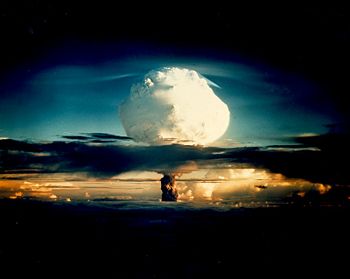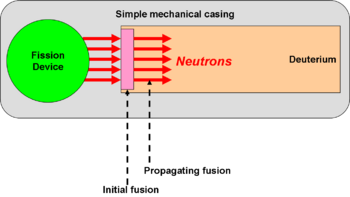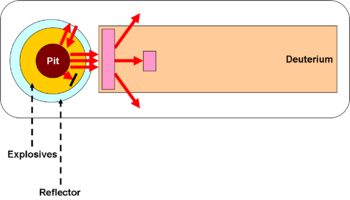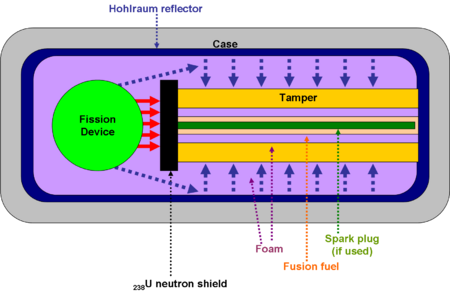Fusion device: Difference between revisions
imported>Howard C. Berkowitz mNo edit summary |
imported>Milton Beychok m (Revised occurrences of incorrect KT and MT to the correct kt and Mt.) |
||
| Line 108: | Line 108: | ||
*''The next idea of the Alarm Clock/Layer Cake/Tamper Boosting was that multiple concentric fission-fusion layers might be possible, again within limits'' | *''The next idea of the Alarm Clock/Layer Cake/Tamper Boosting was that multiple concentric fission-fusion layers might be possible, again within limits'' | ||
While the U.S. did not pursue the Alarm Clock, the Soviets did test the RDS-6 Layer Cake on 12 April 1953, giving a yield of 400 | While the U.S. did not pursue the Alarm Clock, the Soviets did test the RDS-6 Layer Cake on 12 April 1953, giving a yield of 400 kt, slightly less than the contingency [[Operation IVY#IVY MIKE#IVY MIKE]] device the U.S. had tested had the American thermonuclear design not worked. <ref name=Rich>{{citation | ||
| title = Spying on the Bomb: American Nuclear Intelligence from Nazi Germany to Iran and North Korea | | title = Spying on the Bomb: American Nuclear Intelligence from Nazi Germany to Iran and North Korea | ||
| author =[[Jeffrey Richelson]] | | author =[[Jeffrey Richelson]] | ||
| Line 156: | Line 156: | ||
As the tamper compresses the thermonuclear fuel, probably [[lithium]] [[deuterium|deuteride]], it heats it. Early Secondaries were built around a plutonium core informally called — the "spark plug" — which underwent fission and provided additional neutrons and compression from the inside. While Secondary design remains classified, however, it is now believed that more efficient compression systems have eliminated the spark plug, allowing further miniaturization. Suggestive of the reason to suspect elimination of the spark plug is the greater energy of tritium reactions, and the U.S. revelation of the fact of some <sub>6</sub>lithium fuels contain [[tritium]] rather than [[deuterium]].<ref> ''Restricted Data Declassification Decisions'', p. 69 </ref> | As the tamper compresses the thermonuclear fuel, probably [[lithium]] [[deuterium|deuteride]], it heats it. Early Secondaries were built around a plutonium core informally called — the "spark plug" — which underwent fission and provided additional neutrons and compression from the inside. While Secondary design remains classified, however, it is now believed that more efficient compression systems have eliminated the spark plug, allowing further miniaturization. Suggestive of the reason to suspect elimination of the spark plug is the greater energy of tritium reactions, and the U.S. revelation of the fact of some <sub>6</sub>lithium fuels contain [[tritium]] rather than [[deuterium]].<ref> ''Restricted Data Declassification Decisions'', p. 69 </ref> | ||
The U.S. tested the weaponized [[Operation Castle#CASTLE BRAVO|CASTLE BRAVO]] bomb on 1 March 1954, yielding an unexpectedly high 14 | The U.S. tested the weaponized [[Operation Castle#CASTLE BRAVO|CASTLE BRAVO]] bomb on 1 March 1954, yielding an unexpectedly high 14 Mt. On November 22, however, the Soviets tested their RDS-37 radiation implosion bomb. <ref>''Spying on the Bomb'', pp. 109-110</ref> It had a 1.6 Mt yield, but that was believed to have been deliberately kept low. <ref>{{citation | ||
| url = http://nuclearweaponarchive.org/Russia/Sovwpnprog.html | | url = http://nuclearweaponarchive.org/Russia/Sovwpnprog.html | ||
| title = The Soviet Nuclear Weapons Program | | title = The Soviet Nuclear Weapons Program | ||
| Line 165: | Line 165: | ||
The combination of a Primary and Secondary is called a "two-stage" design, assuming the Hohlraum is radioactively inert. In a "three-stage" design, such as the [[nuclear weapon, W41|B41 bomb]], the Hohlraum is made of Uranium-238, which is not normally fissionable. Bombarded with neutrons from the Secondary, the Hohlraum converts to a fissionable isotope, and then undergoes fission. In principle, there can be more than three stages, and there is no theoretical limit to the power of a thermonuclear device. | The combination of a Primary and Secondary is called a "two-stage" design, assuming the Hohlraum is radioactively inert. In a "three-stage" design, such as the [[nuclear weapon, W41|B41 bomb]], the Hohlraum is made of Uranium-238, which is not normally fissionable. Bombarded with neutrons from the Secondary, the Hohlraum converts to a fissionable isotope, and then undergoes fission. In principle, there can be more than three stages, and there is no theoretical limit to the power of a thermonuclear device. | ||
[[RDS-220 (nuclear weapon)|RDS-220]], known to its designers as Big Ivan, and nicknamed [[Tsar Bomba]], was the highest-yielding nuclear weapon ever developed. Its <sub>238</sub>U Tertiary was replaced by lead to reduce its designed yield of 100 | [[RDS-220 (nuclear weapon)|RDS-220]], known to its designers as Big Ivan, and nicknamed [[Tsar Bomba]], was the highest-yielding nuclear weapon ever developed. Its <sub>238</sub>U Tertiary was replaced by lead to reduce its designed yield of 100 Mt to 50-58 Mt.<ref>{{citation | ||
|title = Big Ivan, The Tsar Bomba (“King of Bombs”): The World's Largest Nuclear Weapon | |title = Big Ivan, The Tsar Bomba (“King of Bombs”): The World's Largest Nuclear Weapon | ||
| date= 3 September 2007 | | date= 3 September 2007 | ||
| Line 172: | Line 172: | ||
| url = http://nuclearweaponarchive.org/Russia/TsarBomba.html}}</ref> Some reports of its design suggest that it used multiple parallel secondaries. | | url = http://nuclearweaponarchive.org/Russia/TsarBomba.html}}</ref> Some reports of its design suggest that it used multiple parallel secondaries. | ||
There has been little work on three-stage devices, because it has been realized that while there may be no theoretical limit on the size of a bomb, there is a practical limit to what is militarily useful. Somewhere in the 50- | There has been little work on three-stage devices, because it has been realized that while there may be no theoretical limit on the size of a bomb, there is a practical limit to what is militarily useful. Somewhere in the 50-100 Mt range, the effects would begin to vent into space; a greater number of smaller and more accurate weapons is far more effective. Neither the Soviet Union nor U.S. ever deployed a weapon with more than 25 Mt yield. | ||
Conceivably, if appropriate ground penetration technology could be developed, a very large bomb might have a role against a very deep underground target. Even in discussions of deflecting asteroids on collision course with Earth, extremely large single explosions do not seem to have a role. | Conceivably, if appropriate ground penetration technology could be developed, a very large bomb might have a role against a very deep underground target. Even in discussions of deflecting asteroids on collision course with Earth, extremely large single explosions do not seem to have a role. | ||
Revision as of 19:07, 8 June 2011

A fusion device is any assembly of components that can produce an explosion from nuclear fusion. A fission bomb can be dropped from an airplane, or at least transported to a real target. In contrast, the first thermonuclear device, IVY MIKE, detonated on Bikini Island, was not transportable. A fusion warhead is a device that is sufficiently small and rugged to be used, operationally, as the warhead of a guided missile, artillery shell, or unguided rocket.
This article describes the general principles of a fusion device, also called a thermonuclear weapon, hydrogen bomb, or simply H-bomb. Rather than generating energy by splitting nuclei, it generates even greater amounts of energy by joining the nuclei of lighter elements (e.g., hydrogen isotopes) into a heavier one (e.g.,helium).
All operational designs use a fission device as the source of neutrons, heat, and compressive energy, although laser fusion is being explored, at least for power fusion and possibly for weapons. [1]
Why fusion?
Thermonuclear fusion generates vastly more energy, per unit of weight of the physical device, than does a pure fission bomb. Fission devices are limited in size because the growing explosion will eventually disrupt the critical mass and stop fission. Fusion, in principle, has no limits as long as neutrons can find fusion fuel. Fission is centralized; fusion is distributed. Indeed, fusion devices are one of the potential doomsday machines that could end all human life.
Fusion fuel is either deuterium or tritium. In a 1946 meeting, Edward Teller emphasized, to policymakers, that deuterium yielded more energy per gram than uranium or plutonium, yet cost twenty cents per gram versus several hundred dollars for the fission fuels. [2] Tritium, however, is far more expensive than deuterium, with a market price in the tens of thousands of dollars per gram, although is easier to trigger and releases more energy.
D + D → 3He + n + 3.25 MeV
D + D → 3T + p + 4.05 MeV
D + T → 4He + n + 17.59 MeV
T + T → 4He + 2n + 11.27 MeV
6Li + n → 4He + T + 4.78 MeV
3He + D → 4He + p + 18.35 MeV
Where
At the time of the original U.S. decision to start fusion weapon development, the military assumption was that the larger an explosive that could be made, the more decisive a weapon it would be. This assumption has changed since the early Cold War, but was reasonable at the time.
"The H-Bomb Secret"
The basic principles, although emphatically not the engineering details, of fission weapons became available shortly after the end of the Second World War. Other than the underlying reaction, however, the principle of operation of fusion weapons was cloaked in secrecy for many years. What was known:
- The most fundamental challenge in fusion devices is to direct adequate neutrons into a mass of hydrogen isotopes receptive to fusion upon the absorption of neutrons
How the receptive mass was created and maintained long enough to sustain a reaction was often called the "H-Bomb Secret". In broad overview, it was exposed by Howard Morland in 1979. [4] Officially, the U.S. government will say,
The fact that, in thermonuclear weapons, radiation from a fission explosive can
be contained and used to transfer energy to compress and ignite a physically
separate component containing thermonuclear fuel. Any elaboration of this statement will be classified. [5]
Prior to that, Ted Taylor observed the "H-bomb secret" was a matter of "design, not materials",[6] although, of special nuclear materials, 235uranium or 239plutonium, 3tritium, and 6lithium or 2deuterium are clearly needed. Context suggests he was thinking of the Teller-Ulam design. In that approach, 238uranium is probably used in the neutron shield, and in a Tertiary if one is used.
U.S. declassification guidance mentions that boron, beryllium, bismuth, tungsten, thallium and mercury are used in some unspecified nuclear weapons, but no detail is given.[7]
Almost certainly, dense plastic foams are a key component and a very sensitive technology. All that has been declassified is "The fact that materials may be present in channels and the term 'channel filler'"[8] with no elaboration.
Early designs
Quite early in the Manhattan Project (summer 1942) and later in the Soviet program, long before anyone had built a fission device, attention was paid to a device that could use the much more energetic fusion reaction. It can be argued there were three early generations in the 1940s: Teller's "Classical Super", the more complex but more feasible multiple-concentric-sphere designs, and the eventual Teller-Ulam design, which is the basis of all operational fusion weapons.
The first two generations shared the property that they had a succession of coupled "layers", each of which amplified some aspect of the previous one, and in some cases established feedback. There was no clear separation between the fission Primary and the fusion Secondary. In contrast, the eventual "multistage" Teller-Ulam design sharply distinguishes between Primary, Secondary, and optional Tertiary.
Classical Super
Edward Teller was among the first theoreticians to approach fusion devices, which he called the "Super", with an early approach that detailed analysis showed would simply not work.
- The basic idea of the super was that a direct flow of neutrons from a fission device would be significant to begin self-sustaining fusion in an arbitrary mass of deuterium
In Teller's basic idea, neutrons from a fission device would strike a cylinder of deuterium and fuse, which would produce more neutrons. The neutrons would continue down the cylinder, with more and more neutrons increasing the reaction.
It was a simple deuterium cylinder inside a simple mechanical case. There was no radiation or mechanical confinement around the fusion fuel.
The next illustration, still simplified in that the tamper and internal voids are not shown, depicts flaws in the Super concept. The first problem was that the fission device was not homogeneous as in the previous illustration. The fissioning pit, which generated the neutrons, was compressed by explosives, composed of low-Z (low atomic number) elements that are good neutron absorbers. Note the neutron absorbed in the explosive layer.
Remember that fission itself needed a high neutron density. For this reason, the pit and explosives were surrounded by a neutron reflector. Some neutrons would be reflected back into the pit, and, while they eventually might reach the deuterium, they might do so after the fuel at the nearest end was partially used, damping a chain reaction.
For those neutrons that do reach the deuterium and cause fusion, there is nothing to direct the fusion-generated neutrons. They may radiate out the sides of the cylinder and cause little or no additional fusion.
Alarm Clock
A variety of interim designs, which could produce greater yield than a pure fission device, were variously called the Alarm Clock by Teller in the U.S., ("because it would wake up the world"),[9] Layer Cake or sloika in the Soviet Union, emphasizing its multiple concentric shells, and tamper boosting in the U.K.[10] Andrei Sakharov called the use of lithium deuteride in the Layer Cake the "second idea".
- The basic idea of the Alarm Clock/Layer Cake/Tamper Boosting was that limited fusion could be produced in a shell of light elements concentric around a fusion device and backed by a reflector, with interactions among the three basic layers
- The next idea of the Alarm Clock/Layer Cake/Tamper Boosting was that multiple concentric fission-fusion layers might be possible, again within limits
While the U.S. did not pursue the Alarm Clock, the Soviets did test the RDS-6 Layer Cake on 12 April 1953, giving a yield of 400 kt, slightly less than the contingency Operation IVY#IVY MIKE#IVY MIKE device the U.S. had tested had the American thermonuclear design not worked. [11]
Later, however, it proved inferior to the subsequent "multistage" or Teller-Ulam design. Indeed, active contingency work continued in increasing the yield of pure fission devices should none of the fusion approaches work; this resulted in the Mark 6 (nuclear weapon) designed by Ted Taylor, better known as the Super Oralloy Bomb ("SOB").
Teller-Ulam design
Many of the details remain classified, but there is reasonable confidence that all current fusion weapons use the Teller-Ulam design, created by Edward Teller and Stanislaw Ulam, in which a fission bomb (i.e., the Primary) is used to generate the radiation that compresses and heats the fusion fuel.[12] Andrei Sakharov, in the Soviet Union, appears to have independently come up with a similar concept, which he called the "third idea".
- The first and critical realization for Teller-Ulam was that X-rays travel at the speed of light, and are the main source of energy produced by a fission device.
- The Teller-Ulam principle is counterintuitive: one of the key elements of design is, for a brief period of time, keeping the Primary neutrons away from the Secondary. They are kept away until the fusion Secondary is prepared to fuse by treatment with X-rays.
- As opposed to the Alarm Clock, the interaction between the Primary and Secondary, and Secondary and Tertiary if there is a third stage, are distinct one-way phases.
The geometry of the bomb is critical. Its case, or at least the inner surface of it, is essential to controlling the reaction.
The original design was cylindrical, with a roughly spherical Primary at one end. The Secondary is a cylinder, concentric with the central axis that runs through the case and the Primary. A neutron shield is placed between the Primary and the Secondary.
These shapes change in recent designs such as the W88, in which the Primary is oblate — think of a watermelon or American football — and the Secondary is spherical. Such shapes fit much more efficiently into a conical missile warhead.
Primary
When the Primary detonates, it produces large volumes of X-rays, which are blocked by the shield, and are reflected along the inner lining of the case, (i.e., called the Hohlraum), surrounding the Secondary, so that the X-rays symmetrically hit the Secondary along its entire length.
In the initial stages of the Secondary reaction, neutrons from the Primary are blocked from reaching the Secondary.
Secondary
The first detailed suppositions suggested that the X-rays caused a dense plastic foam, filling the gap between the case and the Secondary, was converted to a plasma, and the plasma heated and compressed the Secondary.[13] Other accounts argued that the X-rays themselves, without an intermediate mechanism, caused the compression. Teller said that the X-ray wavelengths are in the "soft" rather than "hard" energy range. Since the X-rays generated by the Primary tend to be hard, there is speculation that the bomb case is the source of the soft X-rays; it generates them when ionized by the hard X-rays from the trigger.
The most generally accepted explanation is that the X-rays vaporize the surface of a "tamper" or "pusher" surrounding the Secondary, and the ablation (evaporation) of the tamper surface, completely symmetrical with respect to the Secondary, drives the pusher against the next layer of fusion fuel. Essentially, the tamper becomes a rocket, with its exhaust being its surface being vaporized.
There has never been official confirmation if one or more of the mechanisms are responsible for fusion bombs. The idea of ablation, however, makes more sense, since experiments with laser fusion do not use a Primary, but compress a small bead of thermonuclear fuel with laser energy hitting its tamper from all sides, compressing the fuel.
As the tamper compresses the thermonuclear fuel, probably lithium deuteride, it heats it. Early Secondaries were built around a plutonium core informally called — the "spark plug" — which underwent fission and provided additional neutrons and compression from the inside. While Secondary design remains classified, however, it is now believed that more efficient compression systems have eliminated the spark plug, allowing further miniaturization. Suggestive of the reason to suspect elimination of the spark plug is the greater energy of tritium reactions, and the U.S. revelation of the fact of some 6lithium fuels contain tritium rather than deuterium.[14]
The U.S. tested the weaponized CASTLE BRAVO bomb on 1 March 1954, yielding an unexpectedly high 14 Mt. On November 22, however, the Soviets tested their RDS-37 radiation implosion bomb. [15] It had a 1.6 Mt yield, but that was believed to have been deliberately kept low. [16]
Additional stages
The combination of a Primary and Secondary is called a "two-stage" design, assuming the Hohlraum is radioactively inert. In a "three-stage" design, such as the B41 bomb, the Hohlraum is made of Uranium-238, which is not normally fissionable. Bombarded with neutrons from the Secondary, the Hohlraum converts to a fissionable isotope, and then undergoes fission. In principle, there can be more than three stages, and there is no theoretical limit to the power of a thermonuclear device.
RDS-220, known to its designers as Big Ivan, and nicknamed Tsar Bomba, was the highest-yielding nuclear weapon ever developed. Its 238U Tertiary was replaced by lead to reduce its designed yield of 100 Mt to 50-58 Mt.[17] Some reports of its design suggest that it used multiple parallel secondaries.
There has been little work on three-stage devices, because it has been realized that while there may be no theoretical limit on the size of a bomb, there is a practical limit to what is militarily useful. Somewhere in the 50-100 Mt range, the effects would begin to vent into space; a greater number of smaller and more accurate weapons is far more effective. Neither the Soviet Union nor U.S. ever deployed a weapon with more than 25 Mt yield.
Conceivably, if appropriate ground penetration technology could be developed, a very large bomb might have a role against a very deep underground target. Even in discussions of deflecting asteroids on collision course with Earth, extremely large single explosions do not seem to have a role.
Laser fusion
In laser fusion, also called inertial confinement fusion (ICF), deuterium and tritium are again compressed, but using non-ionizing radiation from multiple lasers, rather than X-rays from a fission explosion. Direct drive ICF directs the laser against the surface of the fusion fuel.
Indirect drive wraps a Hohlraum around the fuel pellet, which, when heated, generates soft X-rays that actually compress the fuel. Indirect drive systems do not require the lasers to be as precisely aimed as in direct drive.
A third approach, dynamic Hohlraum, uses concentric cylinders of tungsten wires, which, when heated by the lasers, form a plasma that impacts a low-opacity target made of plastic foam. "The shock wave produced by this collision transfers a portion of the kinetic energy of the pinch implosion to internal and radiative energy within the foam. As the tungsten wires ablate, merge, and implode, the resulting high-atomic number plasma functions as a hohlraum, trapping radiation within."[18]
References
- ↑ Carey Sublette, "Thermonuclear Weapons Design", Nuclear Weapons Archive
- ↑ Richard Rhodes (1995), Dark Sun: the Making of the Hydrogen Bomb, Simon & Schuster, ISBN 068480400X, p. 254
- ↑ Dark Sun, p. 508
- ↑ Howard Morland (November 1979), "The H-Bomb Secret: to know how is to ask why", Progressive, p. 3
- ↑ Restricted Data Declassification Decisions, 1946 to the Present, U.S. Department of Energy, 1 January 2002, RDD-8, p. 80
- ↑ John McPhee (1974 (original)), The Curve of Binding Energy, Farrar, Straus and Giroux
- ↑ Restricted Data Declassification Decisions, pp. 14, 35
- ↑ Restricted Data Declassification Decisions, p. 82
- ↑ Carey Sublette, 4.3.3 The Alarm Clock/Layer Cake Design, 4.3 Fission-Fusion Hybrid Weapons, Nuclear Weapons Archive
- ↑ Donald McIntyre (2006), The Development of Britain’s Megaton Warheads, University of Chester, MA Dissertation, pp. 20-27
- ↑ Jeffrey Richelson (2006), Spying on the Bomb: American Nuclear Intelligence from Nazi Germany to Iran and North Korea, W.W. Norton, ISBN 9780394053838, pp. 100-101
- ↑ ""Teller-Ulam" Summary", Nuclear Weapons Archive
- ↑ Howard Morland (November 1979), "Errata", Progressive, p. 35
- ↑ Restricted Data Declassification Decisions, p. 69
- ↑ Spying on the Bomb, pp. 109-110
- ↑ Carey Sublette (12 December 1997), RDS-37: The First Soviet Superbomb ("True H-Bomb") Test, The Soviet Nuclear Weapons Program
- ↑ Carey Sublette (3 September 2007), Big Ivan, The Tsar Bomba (“King of Bombs”): The World's Largest Nuclear Weapon, Nuclear Weapons Archive
- ↑ Thomas W. L. Sanford (10 November 2006), Overview of the Dynamic-Hohlraum X-ray Source at Sandia National Laboratories



